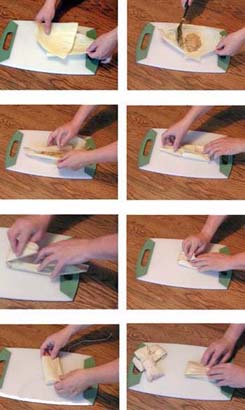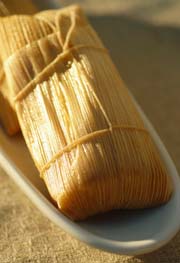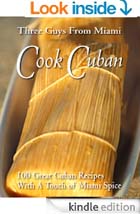Raúl Musibay: Our cousins from the Eastern part of Cuba (Cuba Oriente) have always been more Caribbean than Spanish, especially in their food.
Jorge Castillo: Santiago de Cuba is the capital of the Eastern province of the same name. Many of the favorite Cuban dishes here have been influenced by Haiti.
Glenn Lindgren: Eastern Cuban dishes can be a little spicier than the rest of Cuba. They're not afraid to use a hot pepper or two to get the blood flowing!
Raúl Musibay: If you traveled way out to Baracoa in Guantánamo province on the Eastern tip of the island, (where Christopher Columbus originally landed) the type of tamales you would get in a restaurant or from a street vendor would be made not with corn, but with mashed plantain!
Jorge Castillo: They do not usually steam their tamales, either. They roast them over charcoal on a grill!
Cuban Tamales de Oriente
By
Prep time: 30 minutesCook time: 1 hour 30 minutes
Total time: 2 hours
Yield: 12-16 tamales
Good Cuban tamales are not stuffed like a Mexican tamal; instead, they are riddled with tiny flecks of meat.
INGREDIENTS:
6 large plantains, green4 quarts chicken stock
8 cloves garlic, minced
2 large green peppers, chopped fine
1 cup green onionschopped
1 hot pepper, whole (habanero, jalapeno, etc. Whatever you can tolerate)
1/2 cup lard, butter, or shortening
1/4 teaspoon bijol (annato seed powder)
1 lemon, juice only
1/2 cup red wine
1 1/2 pounds pork in chunks
salt and pepper to taste
24-32 dried corn husks (Soak dried cornhusks in hot water before using)
Cut the ends off the plantains and discard. Slice each plantain into two-inch chunks and score the skin with a knife along one edge. DO NOT PEEL.
In a large pot, add the plantains to the chicken stock. Bring to a boil, then lower heat, cover and simmer until tender.
For meat, you need pork with plenty of fat -- either well marbled or with a fat layer or both. We've had good luck with de-boned pork ribs. Or have the butcher cut something to order.
Whichever meat you use, you need to slice it into small pieces -- approximately one inch square. Add a little salt with a shaker and place in a large sauce pan. Add water to just barely cover the meat. Add the hot pepper to the water. Bring to a boil; reduce heat and simmer, uncovered until all of the water has boiled away.
REMOVE THE HOT PEPPER AND DISCARD.
Fry the pork pieces in the rendered fat just until brown, but NOT crispy!
Remove the meat. Trim off any excess fat (there shouldn't be any) and with a knife or meat hammer; break up the meat into tiny pieces.
Sauté the garlic, green pepper, and onion in the rendered fat at medium temperature, three to five minutes. During the last minute, add the lemon juice, wine, and Bijol powder.
Remove the fully cooked plantains from the broth (do not discard the broth) and peel. Mash the plantains with a little of the broth -- just enough to make a soft, thick paste -- like mashed potatoes. Blend in the fat of your choice -- lard, butter, or shortening. (Save the leftover chicken broth for use in other recipes.)
Mix the mashed plantains together with the vegetables and the fried pork. Add salt and pepper to taste.
OUR COOKBOOKS ARE NOW AVAILABLE AS KINDLE EBOOKS!
This new Kindle version contains all of the recipes and editorial copy from the original print edition. As a bonus, the new Kindle edition includes 14 new photos of the prepared dishes.
No Kindle?
Use the FREE Kindle Reading App and view our cookbooks on your notepad, tablet, laptop, or computer.

To make tamales:
Take two husks and overlap them flat on the table. Put some of the mixture in the center of the cornhusks. Fold the cornhusks over and around the meat. Tie with string.
To be authentic, fire up the grill and roast the tamales over hot coals, turning frequently until very hot.
Or just cook them in a steamer. You can also use a large pot about a quarter full of water. (If you have the little insert that keeps the food off the bottom, great!) Bring the water to a boil. Add the tamales, standing them on end and cover. Reduce heat and simmer 90 minutes to two hours, checking water occasionally so that the pot doesn't run dry.
Three Guys From Miami Show You How to Make the Best Cuban, Spanish, and Latin American Food!
Drinks | Appetizers | Salads | Main Dishes| Soups | Side Dishes | Desserts | Index

Visit All of Our Sites:
Three Guys From Miami:
Cuban, Spanish, and Latin American food recipes, Miami/Little Havana Travel Guide, Miami Restaurant Guide, Hispanic Culture & Food
The Three Guys From Miami are: Raúl Musibay, Glenn Lindgren, and Jorge Castillo
Check out The Three Guys From Miami's Google+ Fan Page
No copying or commercial duplication of any content (including photos) without the express written permission of the authors and proper attribution.





